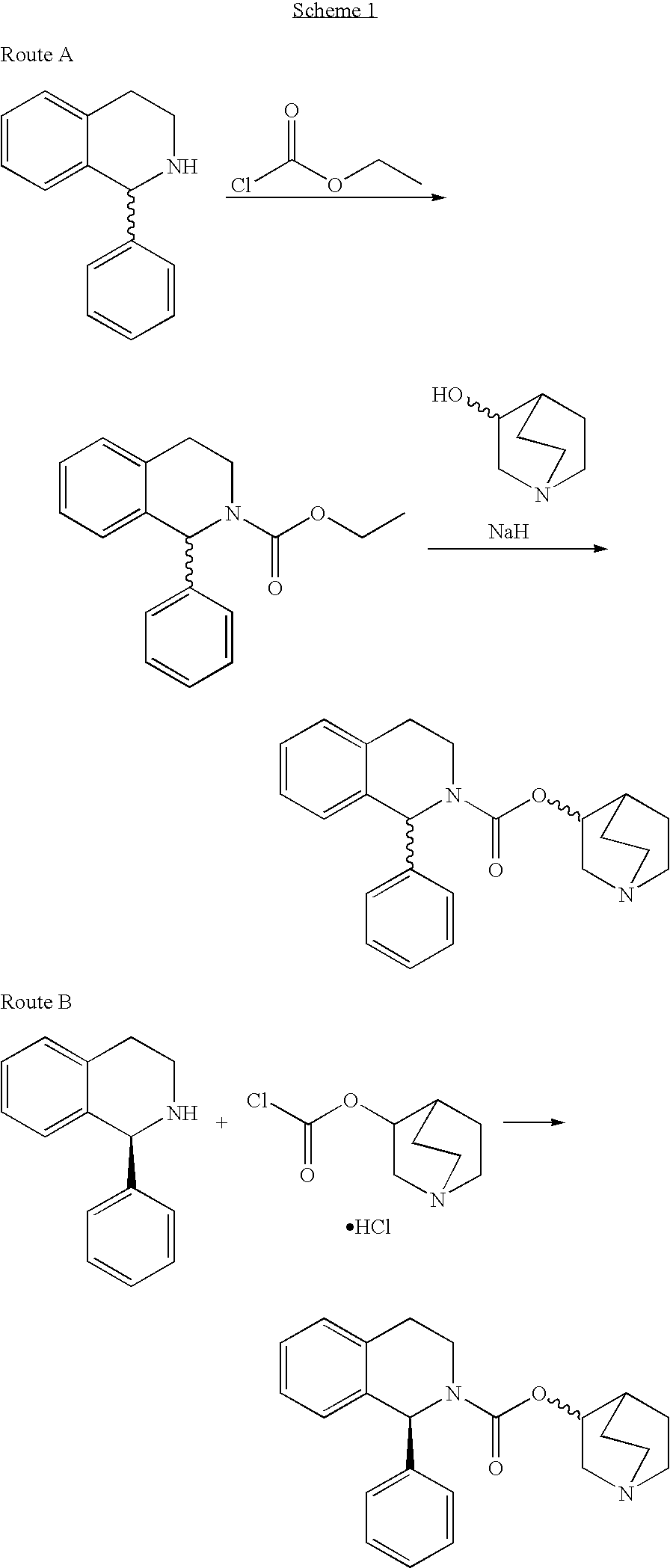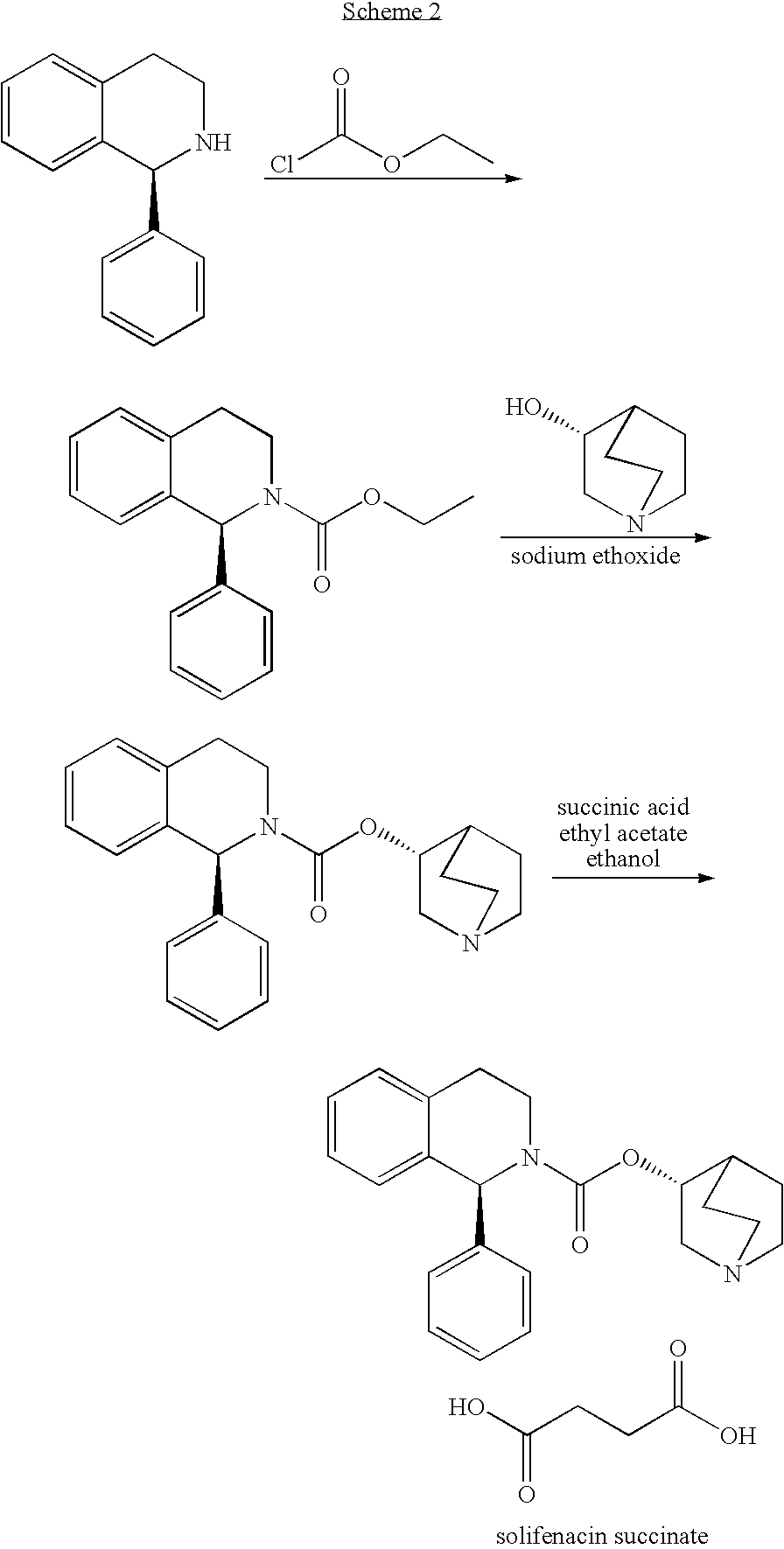Process for the synthesis of solifenacin
a technology of solifenacin and synthesis process, which is applied in the field of process for the synthesis of solifenacin, can solve the problems of troublesome control of reaction, low efficiency or industrial scale-up of solifenacin preparation, and described processes, and achieves simple experimental procedures, reduced work-up, and efficient and simplified methods
- Summary
- Abstract
- Description
- Claims
- Application Information
AI Technical Summary
Benefits of technology
Problems solved by technology
Method used
Image
Examples
specific examples
[0018]The following examples are for illustrative purposes only and are not intended, nor should they be interpreted, to limit the scope of the invention.
[0019]The following HPLC methods were used to determine the purity of the reactants and the solifenacin succinate product. The process as described in Examples 1 and 2 refer to the HPLC methods used as HPLC method 1 to 4.
General Experimental Conditions:
[0020]i) HPLC Method 1 (Chiral)
[0021]The chromatographic separation was carried out in a Chiralcel OD-H, 5 μm, 250×4.6 mm I.D column; at 45° C.
[0022]The mobile phase was prepared by mixing 975 volumes of n-hexane, 25 volumes of 2-propanol and 2 volumes of diethylamine.
[0023]The chromatograph was equipped with a 235 nm detector and the flow rate was 1.0 ml per minute. The test samples was prepared dissolving 200 mg of the sample in 2 ml of chloroform, adding 3 ml of benzoic anhydride solution prepared by dissolving 4 g of benzoic anhydride in 10 ml of chloroform and stirring for 20 mi...
example 1
[0039]Into a 1 liter reaction vessel equipped with mechanical stirring, heating system, reflux condenser, addition funnel and innertized with nitrogen were charged: 29.47 g of bis-[1H-1,2,4-triazol-1-yl]-methanone (also named as 1,1-carbonyl-di-(1,2,4-triazole, 0.1676 mol, 93% purity) and 73 ml of isopropyl acetate. The mixture was stirred to homogenize and 21.31 g (0.1676 mol) of (R)-quinuclidin-3-ol [HPLC (method 1) purity: 96.03%, enantiomeric excess by HPLC (method 1)=99.26%] was added stepwise. 39.9 ml of Triethylamine (0.2863 mol) were also added and the mixture was stirred at room temperature for about 2 hours. At this point, a solution consisting of 29.22 g (0.1396 mol) of (S)-1-phenyl-1,2,3,4-tetrahydroisoquinoline [HPLC (method 2) purity: 97.81%, enantiomeric excess by HPLC (method 2)=97.80%] and 204 ml of isopropyl acetate was added stepwise and aged for 4 hours at reflux.
[0040]The resulting mixture was cooled down and washed with 170 ml of saturated aqueous ammonium chlo...
example 2
[0045]Into a 28 liters capacity, cylindrical, glassy reactor equipped with an anchor impeller and purged with nitrogen, 606.80 g (99.10% essay, 3.33 mol) of 1,1′-carbonyl-di-(1,2,3,4-triazole) (CDT) and 1.2 liters of isopropyl acetate were charged. The mixture was stirred to homogenize and 425 g (3.34 mol) of quinuclidin-3-ol were added. Then, 577 g (790 ml, 5.70 mol) of triethylamine were added, washing the addition funnel with 259 ml of isopropyl acetate.
[0046]The mixture was heated up to reflux and a solution consisting on 581 g (2.78 mol) of 1(S)-1-phenyl-1,2,3,4-tetrahydroisoquinoline in 4076 ml of isopropyl acetate we added, washing the addition device with 291 ml of the same solvent.
[0047]The mixture was heated and refluxed for 4 h and cooled down to 0-5° C., at which point a saturated solution of ammonium chloride (prepared from 1800 g of ammonium chloride and 4610 g of water) was added. Temperature was kept at about 0-5° C. in the beginning of the addition. 1.164 kg of wate...
PUM
| Property | Measurement | Unit |
|---|---|---|
| Fraction | aaaaa | aaaaa |
| Fraction | aaaaa | aaaaa |
| Fraction | aaaaa | aaaaa |
Abstract
Description
Claims
Application Information
 Login to View More
Login to View More - R&D
- Intellectual Property
- Life Sciences
- Materials
- Tech Scout
- Unparalleled Data Quality
- Higher Quality Content
- 60% Fewer Hallucinations
Browse by: Latest US Patents, China's latest patents, Technical Efficacy Thesaurus, Application Domain, Technology Topic, Popular Technical Reports.
© 2025 PatSnap. All rights reserved.Legal|Privacy policy|Modern Slavery Act Transparency Statement|Sitemap|About US| Contact US: help@patsnap.com



